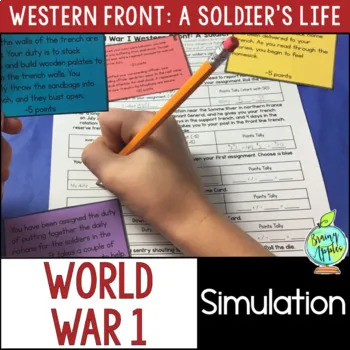World War 1 Simulation Activity, A Soldier's Life in the Trenches
- PDF
What educators are saying
Description
World War 1 Simulation: A Soldier's Life in the Trenches
History can be difficult for students to understand and experience. Simulations help students put themselves in the past, learning about history in an authentically engaging way. Students love simulations because they don't know what the final outcome will be. It's an exciting learning experience!
Want to try a FREE simulation? You can download my free World War 2 Battle of Iwo Jima simulation to get a closer look!
This minimal prep simulation puts students in the role of a Western Front World War I soldier. Students will learn about a trench soldier's life and what they went through while stationed in the trenches. This resource is aligned to my World War 1 Unit Bundle.
This World War 1 simulation includes:
★ 36 soldier ID cards
★ 20 Allied message cards
★ 20 Axis message cards
★ encrypted message template
★ cipher disc template
★ Europe map
★ Pacific map
★ student simulation recording page
★ teacher instructions page
★ extension task page
The cards have a colored background to differentiate between the different types. However, if you prefer to save color ink, I have included black line versions, and you can print onto colored paper. The only item you need besides what is included in this resource is one die. That's it! Everything else you need is right here!
Students begin the simulation with 50 points. Students want to end the simulation with as many points as possible. As students progress through this simulation, there are different ways in which their fates are determined. Sometimes students simply draw a card and their fate is shown, sometimes students have to roll a die, and sometimes students can make a free choice. Each decision affects their fate. There are multiple outcomes based on the cards drawn, the choices students make, and what the student rolls. Students can go through this simulation multiple times and have a different outcome each time!
My students LOVE simulations! Not only are they engaging and fun, but students are also LEARNING more about the topic.
This simulation is included in my World War 1 Curriculum Unit. If you are looking for comprehensive curriculum, be sure to check it out.
++++++++++++++++SIMULATIONS Available++++++++++++++++
♦Colonial America: A New Life in Plymouth
♦American Revolution: No More Taxes!
♦Constitution & a New Nation: Lewis and Clark Expedition
♦Age of Jackson & Sectionalism: California Gold Rush
♦Gilded Age: Life of a Factory Worker
♦World War 1: A Soldier's Life in the Trenches
♦Roaring '20s & Great Depression: Life of a Farmer
♦World War 2: Battle of Iwo Jima FREE
©Heather LeBlanc, LLC
Brainy Apples





